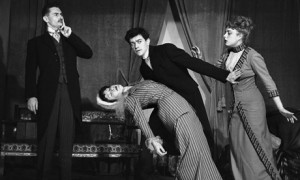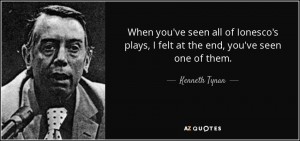The Bald Soprano since its opening in 1950 has become one of the most widely performed pieces of modern French drama and holds the record both for the number of countries it was produced in and for longest run.[1] In the United States, it is most popular at the high school and college level, but several notable productions have appeared in off-Broadway and regional theatres since 1950 as well. Despite the more current popularity of the play, when The Bald Soprano first opened, it was largely ignored when it first opened until several established critics and writers championed it to the larger public, and, within a decade after its opening, The Bald Soprano was already recognised as a modern classic.
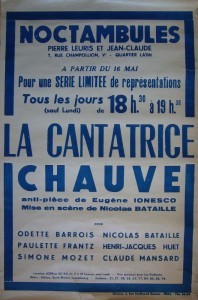
An original poster for The Bald Soprano
Img. Credit: http://www.theatre-huchette.com/en/un-peu-dhistoire-en/spectacle-ionesco-en/
The Bald Soprano first opened on May 11, 1950 at the Théâtre des Noctambules in Paris under the direction of Nicolas Baitalle, who also played Mr. Martin with a set designed by Jacques Noel. Noel created a set that resembled one for Hedda Gabler at the request of Baitalle and the play as audiences know it today was created in the byplay between Ionesco and the actors led by Baitalle early in the rehearsal process.[2] One of the most notable changes was the creation of the title that came about when the actor playing the Fire Chief mistakenly read a line as “cantatrice chauve” instead of “institutrice blonde.” The creation of the cyclical ending of the piece was also an invention of Baitalle and Ionesco’s collaboration after Baitalle suggested that the written ending of having the author come onstage and “gun down” the audience wouldn’t go over well and that a real ending was needed. Baitalle also experimented with the acting technique used to convey the piece and discovered that if the play was attempted to be played as a comedy, it fell flat but when performed like a tragedy, the absurdity of the piece was heightened.[3] There are no English reviews (and very few surviving French ones) of the original production, but instead what survives are Ionesco and Baitalle’s notes and interviews about the early days of the show and the rehearsal process.
In the early months of the production, some nights the audience numbered less than 10 and without the writings of several established writers proclaiming the revolutionary nature of the piece, it is likely that the production would not have become as well-known as it is today.[4] In 1957, The Bald Soprano, paired with The Lesson, was moved to it’s now permanent home at the Théâtre de la Huchette where it has been in continuous performance since as an institution now known as “The Ionesco Show.”[5]
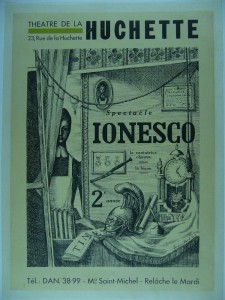
The original poster for what is now know as The Ionesco Show.
Img. Credit: http://www.theatre-huchette.com/en/un-peu-dhistoire-en/spectacle-ionesco-en/
The first English language production of The Bald Soprano was in 1956 at the Arts Theatre in London and was directed by Peter Wood. Shortly afterwards, Kenneth Tynan began his campaign to get Ionesco better known in England first with his essay “Theatre and Life” and later with various other writings. He, at first, praised Ionesco’s innovations and his creation of an escape from reality, but later in 1958 as Ionesco was gaining popularity in England published a review in The Observer railing against Ionesco’s method for “casting off of the fetters of realism.”[6] In this review, Tynan accepts that Ionesco and his plays offer an escape from realism, but that it is an escape into a blind alley, adorned with tachiste murals that paint a bleak new world for the theatre of the future. In sum, “M. Ionesco’s theatre is pungent and exciting, but it remains a diversion. It is not on the main road; and we do him no good, nor the drama at large, to pretend that it is.”[7]
Ionesco’s response to his main critic is preserved in his Notes and Counternotes as he set out what he believed was the role of the playwright, “A playwright simply writes plays, in which he can offer only a testimony, not a didactic message…or he can express his feelings, comic or tragic, about life.”[8] Ionesco’s response not only provoked Tynan, but also led to several other critics replying to his theories on the role of the play and the playwright. These reviews and essays focused solely on the merits of Ionesco’s style of writing instead of the merits of the performances of his plays in an effort to take a stance on which way drama should go.
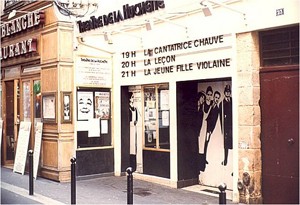
Théâtre de la Huchette, where The Bald Soprano has been running continuously since 1957.
Img. Credit: Théâtre de la Huchette
A more recent revival of The Bald Soprano at the Cubiculo theatre in New York City in 1987 represents, in the critic’s opinion, the return of a quality Ionesco work to New York.[9] In his review, Gussow, like the critics before him, does focus on the language of the piece and how he and the audience interacts with it, but he also examines how the acting choices made further heighten and interact with the piece. He mainly notes, “The acting is more serious than one customarily finds in Ionesco, but the play is no less funny.”[10] Gussow also notes the sparseness of the stage in this production and praises the specificity of the costumes. In 1993, the second Ionesco Festival brought Baitalle’s staging of The Bald Soprano back to Los Angeles to be put on the tiny stage both he and Ionesco intended it to be on. This production was also directed by Baitalle, but the set itself was a far cry from that of the original production or the Huchette set. Instead, it featured a “macabre Victorian set” designed by Robert Zentis that better gelled with the American view of The Bald Soprano as a nutty, British domestic comedy.[11]
[1] Lamont, Rosette C. Ionesco’s Imperatives. Ann Arbor: University of Michigan Press, 1993. Print.
[2]Koehler, Robert. “Present at Birth of Theater of the Absurd Stage: Director Nicolas Bataille brings to Hollywood the play that brought him and its author a piece of history-Ionesco’s `The Bald Soprano’” Los Angeles Times 20 March 1993. Print.
[3] Koehler, Robert. “Present at Birth of Theater of the Absurd Stage: Director Nicolas Bataille brings to Hollywood the play that brought him and its author a piece of history-Ionesco’s `The Bald Soprano’” Los Angeles Times 20 March 1993. Print.
[4] Gilman, Richard. The Drama is Coming Now. New Haven: Yale University Press, 2005. Print.
[5] “The Ionesco Show.” Théâtre de la Huchette. Théâtre Parisiens Associes. 2013. Web. 30 May 2016.
[6] Tynan, Kenneth. Curtains. New York: Atheneum, 1961. Print.
[7] Tynan, Kenneth. Curtains. New York: Atheneum, 1961. Print.
[8] Ionesco, Eugène. Notes and Counternotes. Trans. Donald Watson. New York: Grove Press, Inc., 1964. Print.
[9] Gussow, Mel. ”Stage: “The Bald Soprano” The New York Times 12 June 1987. Print.
[10] Gussow, Mel. ”Stage: “The Bald Soprano” The New York Times 12 June 1987. Print.
[11] Koehler, Robert. “Present at Birth of Theater of the Absurd Stage: Director Nicolas Bataille brings to Hollywood the play that brought him and its author a piece of history-Ionesco’s `The Bald Soprano’” Los Angeles Times 20 March 1993. Print.


